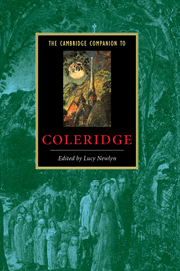2 - The ‘Conversation’ poems
from Part I - Texts and contexts
Published online by Cambridge University Press: 28 May 2006
Summary
In a copy of Sibylline Leaves (1817), Coleridge wrote on the page that began 'The Eolian Harp':
Let me be excused, if it should seem to others too mere a trifle to justify my noticing it - but I have some claim to the thanks of no small number of the readers of poetry in having first introduced this species of short blank verse poems - of which Southey, Lamb, Wordsworth, and others have since produced so many exquisite specimens.
In Sibylline Leaves 'The Eolian Harp' was placed among 'Meditative Poems in Blank Verse' with poems we now call 'Conversation Poems'. George McLean Harper coined the term 'Conversation Poems' in 1928, borrowing the subtitle of 'The Nightingale. A Conversation Poem' and following the epigram from Horace to 'Reflections on Having Left a Place of Retirement': 'Sermoni propriora', 'more fitted to conversation or prose'. Harper described them as 'poems of friendship', since they were all written to a close friend, and included in the category 'The Eolian Harp' (Aug. 1795), 'Reflections of Having Left a Place of Retirement' (Oct. 1796), 'This Lime-Tree Bower My Prison' (July 1797), 'Frost at Midnight' (Feb. 1798), 'The Nightingale' and 'Fears in Solitude' (both April 1798), 'Dejection: An Ode' (April 1802) and 'To William Wordsworth' (Jan. 1807).
- Type
- Chapter
- Information
- The Cambridge Companion to Coleridge , pp. 32 - 44Publisher: Cambridge University PressPrint publication year: 2002
- 5
- Cited by



